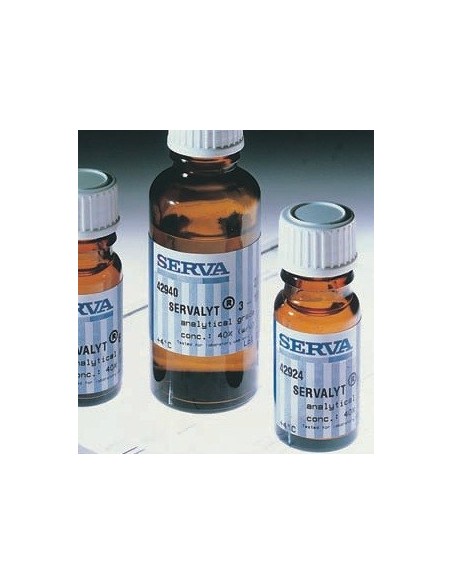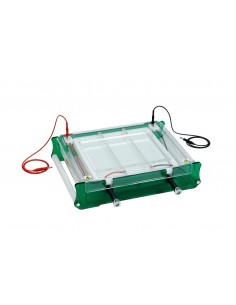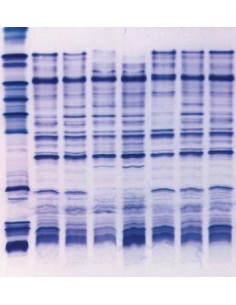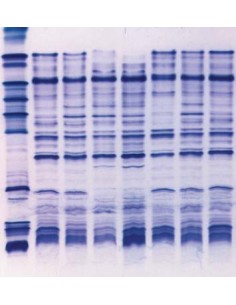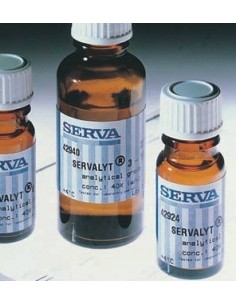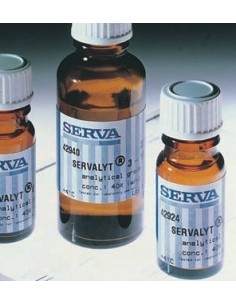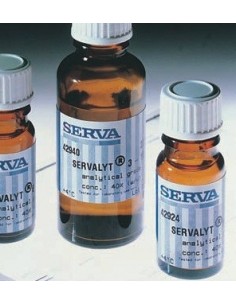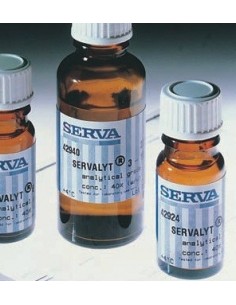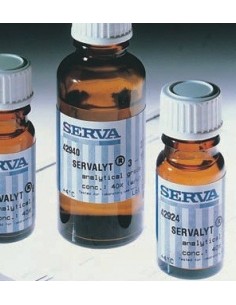Ampholyte pH 3-5 (Servalyt 3-5)
Carrier Ampholytes 3-5
SERVALYT™ 3-5 ampholytes are useful in gel IEF and cIEF to identify acidic isotypes in purified protein samples such as monoclonal antibodies or other biosimilar protein products.
Ampholytes are supplied as 40 % aqueous concentrate and sterile filtered (0.2 μm). If stored at 4 °C and unopened shelf is up to 3 years. The common working concentration is in the range of 3 % to 5 %. Suitable for isoelectric focusing, free flow electrophoresis and capillary electrophoresis (cIEF).
Benefits:
- Available Two Sizes: 10 ml & 25ml
- High Resolution
- Widest Range Available
- Fast Staining and Clear Background
- Ready to Use or Blending
- 3 year shelf life
Instructions for Servalyt carrier ampholytes
Comparison of different brands of carrier ampholytes
Using an ampholyte pH 3-5 in isoelectric focusing (IEF) offers several applications and benefits, including:
Specific separation of low pI proteins: The narrow pH range of 3-5 is ideal for the separation of proteins with low isoelectric points (pI). It allows for targeted separation and resolution of acidic proteins that have pI values within this range. This is particularly valuable when analyzing samples enriched in acidic proteins or when focusing on specific low pI proteins of interest.
High resolution for acidic proteins: The use of an ampholyte pH 3-5 enables high-resolution separation of proteins with acidic characteristics. The narrow pH gradient created by the ampholytes allows for precise migration and focusing of these proteins at their respective pI positions. This results in sharp and well-resolved protein bands, facilitating accurate identification and characterization.
Minimization of interference: By using an ampholyte pH 3-5, the focusing range is limited to the acidic region, minimizing potential interference from proteins with higher pI values. This is especially advantageous when dealing with complex samples containing a mixture of proteins with varying pI values. It allows for selective separation and analysis of the low pI acidic fraction.
Improved sensitivity for low pI proteins: The focused separation of low pI proteins achieved with an ampholyte pH 3-5 can enhance the sensitivity of detection methods. When analyzing low abundance acidic proteins, the reduced complexity of the pH range can lead to improved detection limits and a higher signal-to-noise ratio.
Simplified experimental setup: The use of a narrow pH range such as 3-5 simplifies the experimental setup for IEF. The preparation of the ampholyte mixture and the establishment of the pH gradient become more straightforward and manageable. This saves time and reduces potential sources of experimental variability.
Research applications: Using an ampholyte pH 3-5 in IEF finds particular relevance in research areas where low pI acidic proteins are of interest, such as studying specific protein isoforms, post-translational modifications, or acidic enzymes. It provides a specialized tool for investigating these acidic components in complex biological samples.
Complementary techniques: IEF with an ampholyte pH 3-5 can be combined with other separation techniques to enhance protein analysis. For example, after the separation of acidic proteins using IEF, subsequent techniques like gel electrophoresis, chromatography, or mass spectrometry can be employed for further characterization, purification, or identification of these proteins.
In summary, using an ampholyte pH 3-5 in IEF offers specific separation and high resolution for low pI acidic proteins, minimizes interference from other proteins, increases sensitivity, simplifies experimental setup, and finds application in research areas focused on acidic protein analysis.
No reviews



